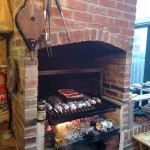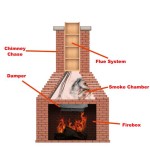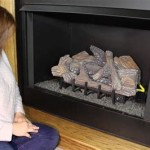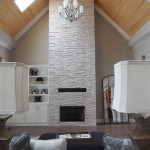Fireplace Surround Ideas: Stone
Stone fireplace surrounds offer a timeless appeal, blending natural beauty with durability. They serve as focal points in living spaces, adding warmth, texture, and a sense of permanence. The versatility of stone allows for a wide range of design possibilities, accommodating various architectural styles and personal preferences. From rustic fieldstone to sleek marble, the options for creating a distinctive fireplace surround are extensive.
Types of Stone for Fireplace Surrounds
Selecting the appropriate stone is crucial for achieving the desired aesthetic and ensuring long-term performance. Several factors influence the choice, including color, texture, cost, and the overall design of the room. Understanding the characteristics of each stone type is essential for making an informed decision.
Granite: Granite is an igneous rock known for its exceptional hardness and durability. Its resistance to heat and scratches makes it a popular choice for fireplace surrounds. Granite is available in a wide array of colors and patterns, ranging from subtle earth tones to bold, vibrant hues. The polished surface of granite provides a sophisticated and elegant look. However, granite can be relatively expensive compared to other stone options.
Marble: Marble is a metamorphic rock prized for its luxurious appearance and unique veining. Its smooth, polished surface reflects light, creating a sense of spaciousness and elegance. Marble is available in various colors, including classic white, grey, and black, as well as more exotic shades. While marble is generally durable, it is more susceptible to staining and scratching than granite and requires regular sealing to maintain its appearance. The cost of marble can vary significantly depending on the rarity and quality of the stone.
Limestone: Limestone is a sedimentary rock composed primarily of calcium carbonate. It has a naturally textured surface and a warm, earthy tone. Limestone is relatively soft and porous, making it easy to carve and shape. It is often used to create intricate details and custom designs. Limestone is more affordable than granite or marble, but it is also more susceptible to staining and weathering. Regular sealing is necessary to protect limestone from moisture and dirt.
Slate: Slate is a fine-grained metamorphic rock known for its distinctive layered appearance and dark, muted colors. It is highly durable and resistant to heat, making it a suitable choice for fireplace surrounds. Slate has a naturally textured surface that adds visual interest and a rustic charm. It is relatively easy to clean and maintain. Slate is generally more affordable than granite or marble, but the availability of specific colors and sizes may be limited.
Fieldstone: Fieldstone refers to naturally occurring stones found in fields and streams. These stones typically have irregular shapes, sizes, and colors, creating a rustic and natural look. Fieldstone fireplace surrounds often evoke a sense of warmth and nostalgia. The cost of fieldstone can vary depending on the availability and location. Installation can be more labor-intensive due to the irregular shapes of the stones. Proper mortar techniques are essential for creating a stable and aesthetically pleasing fieldstone fireplace surround.
Manufactured Stone Veneer: Manufactured stone veneer, also known as faux stone, is a lightweight alternative to natural stone. It is made from concrete or other composite materials and molded to resemble the appearance of natural stone. Manufactured stone veneer is available in a wide range of colors, textures, and styles. It is generally more affordable and easier to install than natural stone. However, manufactured stone veneer may not have the same durability and longevity as natural stone. It is important to choose a high-quality product that is specifically designed for fireplace surrounds.
Design Considerations for Stone Fireplace Surrounds
The design of a stone fireplace surround should complement the architectural style of the room and reflect the homeowner's personal taste. Several factors should be considered when planning a stone fireplace surround, including the size and shape of the fireplace, the desired style (e.g., rustic, modern, traditional), and the overall color palette of the room.
Scale and Proportion: The size of the stone fireplace surround should be proportional to the size of the room and the fireplace opening. A large fireplace surround in a small room can overwhelm the space, while a small fireplace surround in a large room may get lost and appear insignificant. The height and width of the surround should be carefully considered to ensure a balanced and harmonious design. The thickness of the stone should also be taken into account. Thicker stones can create a more substantial and imposing look, while thinner stones can provide a more streamlined and modern appearance.
Style and Aesthetic: The style of the stone fireplace surround should complement the overall aesthetic of the room. A rustic fireplace surround with fieldstone or ledger stone may be appropriate for a log cabin or a country-style home. A modern fireplace surround with sleek granite or marble may be a better choice for a contemporary apartment or a minimalist living space. The color and texture of the stone should also be consistent with the room's color palette and décor. Consider the existing textures and materials in the room, such as wood, metal, and fabric, and choose a stone that complements these elements.
Hearth Design: The hearth is the area in front of the fireplace opening. The hearth should be made of a non-combustible material, such as stone, brick, or tile. The size and shape of the hearth should be proportional to the fireplace surround and the room. A larger hearth can provide a more substantial and grounding effect, while a smaller hearth can create a more streamlined and modern look. The hearth can be flush with the floor or raised above the floor. A raised hearth can function as a seating area or a display surface. The material of the hearth should complement the stone used for the fireplace surround.
Mantel Integration: A mantel is a shelf that is installed above the fireplace opening. The mantel can be made of wood, stone, or other materials. A mantel can provide a decorative element and a functional surface for displaying art, photographs, or other objects. The style of the mantel should complement the stone fireplace surround and the overall aesthetic of the room. Consider the color and texture of the stone when selecting a mantel. A contrasting mantel can create a focal point and add visual interest. The height of the mantel should be carefully considered to ensure that it is not too high or too low. A general rule of thumb is to place the mantel at a height of approximately 12 inches above the fireplace opening.
Surround Details: Various details can enhance the appearance of a stone fireplace surround. These details include corbels, keystones, moldings, and inlays. Corbels are decorative brackets that support the mantel or the top of the surround. Keystones are wedge-shaped stones that are placed at the top of an arch or a fireplace opening. Moldings are decorative strips of material that are used to trim the edges of the surround. Inlays are decorative patterns or designs that are embedded into the surface of the stone. These details can add visual interest and character to the fireplace surround. Consider the overall style of the room when selecting these details. Simple and understated details may be appropriate for a modern fireplace surround, while more elaborate and ornate details may be suitable for a traditional fireplace surround.
Installation and Maintenance of Stone Fireplace Surrounds
Proper installation is crucial for ensuring the safety and longevity of a stone fireplace surround. It is generally recommended to hire a qualified contractor with experience in stone masonry. The installation process typically involves preparing the fireplace opening, applying mortar, setting the stones, and grouting the joints. Regular maintenance is also necessary to keep the stone fireplace surround looking its best.
Professional Installation: Installing a stone fireplace surround requires specialized skills and knowledge. A qualified contractor can ensure that the surround is properly installed and meets all safety codes. The contractor will typically assess the existing fireplace opening and make any necessary modifications. They will then apply mortar to the back of the stones and carefully set them in place. The joints between the stones will be filled with grout. The contractor may also apply a sealant to protect the stone from moisture and staining. Hiring a professional contractor can save time and effort and ensure that the fireplace surround is installed correctly.
Mortar Selection and Application: The choice of mortar is important for the durability and appearance of the stone fireplace surround. The mortar should be compatible with the type of stone being used. There are different types of mortar available, including Type N, Type S, and Type M. Type N mortar is a general-purpose mortar that is suitable for most applications. Type S mortar is a stronger mortar that is used for load-bearing walls and foundations. Type M mortar is the strongest type of mortar and is used for heavy-duty applications. The mortar should be mixed according to the manufacturer's instructions. The mortar should be applied evenly to the back of the stones and to the fireplace opening. The stones should be pressed firmly into the mortar to ensure good adhesion.
Sealing and Cleaning: Sealing the stone fireplace surround can help to protect it from moisture, staining, and weathering. The type of sealant that is used will depend on the type of stone. Some stones, such as granite and marble, are naturally resistant to staining and may not require sealing. Other stones, such as limestone and slate, are more porous and should be sealed regularly. The sealant should be applied according to the manufacturer's instructions. Regular cleaning is also necessary to keep the stone fireplace surround looking its best. The stone should be cleaned with a mild soap and water solution. Avoid using harsh chemicals or abrasive cleaners, as these can damage the stone. A soft brush or cloth can be used to remove dirt and grime. The fireplace surround should be allowed to dry completely after cleaning.
Ventilation and Safety: Proper ventilation is essential for the safe operation of a fireplace. The fireplace should be connected to a properly functioning chimney. The chimney should be inspected regularly for cracks or obstructions. A carbon monoxide detector should be installed in the room to alert occupants to the presence of dangerous levels of carbon monoxide. The fireplace should never be left unattended while it is burning. Children and pets should be kept away from the fireplace. Flammable materials should be kept away from the fireplace. Follow all safety precautions when operating a fireplace.

50 Sensational Stone Fireplaces To Warm Your Senses

Stone Fireplace Surround Ideas You Ll Love Columbia Mo

50 Sensational Stone Fireplaces To Warm Your Senses
:strip_icc()/Screenshot2021-10-19at09-16-46Portfolio-AmyBartlamPhotography-1f35ea9ec29846779a2d62b42676eff9.png?strip=all)
20 Best Stone Fireplace Ideas

Stone Veneer Interior Design Living Room Kitchen Bedroom Ideas More Buechel

Natural Stacked Stone Veneer Fireplace Ideas

50 Sensational Stone Fireplaces To Warm Your Senses

Stone Veneer Fireplace Ideas That Will Warm Up Your Home Ply Gem

Stone Fireplace Design And Remodel

Fireplaces Eldorado Stone








